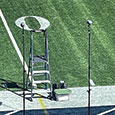When I was in high school my band director often would shout, “Listen!” during rehearsals. That seemed normal at the time, but I now realize this was a classic case of miscommunication. He thought he was giving clear instructions and I thought I was listening as closely as possible, but little was actually happening. A director can certainly make a significant difference in a student’s ability to listen, but it requires more than saying, “Listen!” The ability to listen must be cultivated. Students must know exactly what to listen for and how to respond to what they hear.
Listen to Self
Directors should provide guidance on how to develop a characteristic tone. It is not accidental that tone is listed first on many adjudication sheets. Tone production is crucial to success as an instrumentalist, and listening to other players is an excellent way to develop a rich, full, characteristic sound. Directors can help their students identify outstanding artists and recordings that can help imprint a specific sound in their mind. This method of developing the inner ear is invaluable for producing a beautiful tone.
As a young horn student I listened to every Dennis Brain recording I could find. Brain had a beautiful, liquid sound and immaculate phrasing. He could make even a length of garden hose sound like an instrument, and I was determined to match his sound. Although I never equalled my idol, his model for expression, phrasing, and richness of tone improved my playing significantly.
Countless available recordings offer a comparable experience for music students today. When teaching students to listen, they should begin during private practice. Students should first listen to themselves, focusing on playing with the most beautiful tone possible, articulating exactly what is indicated on the page, and observing dynamics and other expressive markings. By emulating the tone and phrasing of the virtuosos on recordings, students begin to open their ears.
Listen to Neighbors
The second level of listening takes place when a student plays with others. During rehearsals directors can help develop this skill by frequently asking whether students are matching pitch with the players on each side of them and the entire section. Students should also focus on matching articulations and phrases.
One of the most ineffective ways to tune an ensemble is to use a digital tuner to tune each person separately, but this is what often happens at the beginning of rehearsal or just before a performance. Tuning students with a tuner causes them to believe that they are now in tune and need not be concerned with intonation any further. They tend to forget that matching pitch is a constant endeavor. It is much more effective to require everyone to use their ears by tuning to the tuba. Try tuning from the bottom of the band’s tessitura to the top at no louder than a mezzo forte. Everyone should always be able to hear the tuba. Lower brass and woodwinds should tune first, then the horns, then the alto and tenor saxophones and euphonium, then the clarinets, flutes, and oboe. The trumpets should tune last because they have the brightest overtones. If they tune earlier in the process, those who tune afterward may unintentionally tune to the trumpets instead of the tuba.
When tuning before a performance, most ensembles do so in a separate room before moving to the stage for the concert. Hot stage lights make a performance space warmer than the warmup room, and everyone’s instrument changes pitch under the influence of the new temperature. Likewise, the pitch will change as the concert progresses and the instruments become even warmer, making it even more important that everyone adjusts pitch constantly by listening to the lowest voice they can hear.
If players are out of tune with each other during a performance, they must adjust so the pitch will become more centered. Often each student is so convinced that his pitch is correct that nobody adjusts. When this happens the ensemble’s intonation suffers throughout the performance. All players have to concede that they may be out of tune. When everyone adjusts, intonation improves dramatically.
The key to adjusting intonation during a performance is to listen to the lowest pitch in the ensemble, because that pitch contains all the octave transpositions of that pitch above it. In most bands the tuba provides that low pitch, but other possible instruments include the bass clarinet, bassoon, or baritone saxophone. These players should sit close to each other, and listen when in unison to match pitches. This will make it much easier for the rest of the ensemble to tune to the fundamental. Skill in pitch discrimination improves with practice.
Articulation and phrasing can be addressed very effectively in sectional rehearsals. If a student is mindful of these issues during private practice, there will be a basis for comparison when listening to others who have the same line. If the ensemble is not articulating or phrasing together, the music becomes muddy and uneven. I often remind young bands to tongue where it says tongue, slur where it says to slur, and avoid breaking the phrase by breathing in the middle. There is no better way to add clarity and smoothness to a line than for everyone to articulate and phrase together, and there is no better way to make this happen than for students to listen to their neighbors in a sectional and make immediate corrections.
Listen to Everybody
The third level is to listen to every part in the ensemble, a difficult skill to master. In addition to solving the problems in the first two levels of listening, directors also must ask students where their parts fit in the texture and the phrase. Students also need to know whether they have the melody, and if not, should be able to hear it over their part.
Students should also focus on balancing and blending with the rest of the ensemble. I often hear bands that are out of balance because the accompaniment lines are too strong. When I give a clinic to such bands, it is relatively easy to adjust their balance by teaching them how to listen to each other. I discuss the idea of a transparent sound that allows the melody to be heard regardless of the dynamic on the page.
I use the analogy of a video of two people talking to each other on a busy street with other people passing between them and a building behind them. The conversation between the two people in the foreground, the most important thing in the video, is the equivalent of the melody. That conversation must be audible regardless of how much street noise is going on. The pedestrians passing back and forth behind them are the middle ground, the equivalent of a countermelody or a line that provides rhythmic interest. That countermelody or rhythmic line is certainly important, but less important than the melody, so the students playing that line must be subordinate to the melody. A request to those students to reduce the strength of their line by 10% often solves the issue.
Finally, the building behind the people is the background. The musical equivalent of the background is the harmonic foundation on which the melody and countermelody float. The harmony is important, but not so important that it covers up the melody; nobody wants to watch a video of just a building. Long tones are almost always less important than a moving line, and the long tones should, like the countermelody, be subordinate to the melody. If the students playing long tones cannot hear the melody, they also must reduce their volume to allow the melody to be the most important element in the overall texture. It helps to have the students with the melody play it for the rest of the ensemble, then gradually add other sections of the ensemble to the melody, while making sure that the melody is always the principal voice in the overall texture.
Sometimes the melody can be so strong that it covers up the middle and background voices. This can happen when a large number of students are playing a unison line marked forte. This is the equivalent of the two people in the video shouting at each other rather than speaking in a normal voice. When I point out that the composer really wants a unison forte rather than twenty individual fortes, the melody usually softens to a more appropriate level. I then encourage the students to listen for those times when both the flutes and clarinets are scored in this fashion and adjust their volume accordingly.
Astute listening from everyone in the ensemble is essential for a successful performance. The ability to listen at all three levels directly relates to how well students know their parts. When players focus intently on the notes on the printed page, such as when sightreading and during early rehearsals, their listening skills are hindered. The more familiar the music is, the easier it becomes for students to engage these listening skills. Likewise, the more proficient and familiar the players are with their music, the more responsive they also will be to these essential elements of listening. The key is to encourage students to listen to themselves, their section, and the entire ensemble every time they play.
Suggested Listening
Suggested Listening
Flute: Jean-Pierre Rampal, Emmanuel Pahud, William Bennett
Clarinet: Richard Stoltzman, Larry Combs, Sabine Meyer
Oboe: Allan Vogel, Wayne Rapier, Elaine Douvas
Bassoon: Judith LeClair, Jeffrey Lyman, Arthur Grossman
Alto Saxophone: Eugene Rousseau, Donald Sinta, Steven Mauk
Tenor Saxophone: Lynn Klock, Roger Greenberg, Harvey Pittel
Trumpet: Alan Vizzutti, Carole Reinhart, Wynton Marsalis, Maurice Andre
Horn: Dale Clevenger, Mason Jones, Barry Tuckwell
Trombone: Joseph Alessi, Mark Lawrence, Christian Lindberg
Euphonium: Brian Bowman, Adam Frey, Tormond Flaten
Tuba: Arnold Jacobs, Patrick Sheridan, Sam Pilafian






